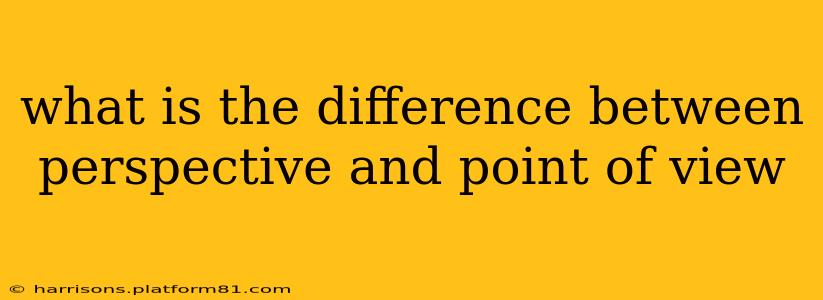Perspective vs. Point of View: Unveiling the Nuances
The terms "perspective" and "point of view" are often used interchangeably, leading to confusion. While closely related, they possess subtle yet significant differences. Understanding these nuances is crucial for clear communication, especially in creative writing, analysis, and critical thinking.
This article delves into the core distinctions between perspective and point of view, clarifying their meanings and providing illustrative examples. We'll also address common questions surrounding these concepts.
What is Point of View (POV)?
Point of view refers to the narrative voice through which a story or account is told. It dictates who is telling the story and how they are experiencing it. Common POVs include:
-
First-person: The narrator is a character within the story, using "I" or "we." This offers intimate access to the narrator's thoughts and feelings, but limits the scope to their experiences. Example: "I woke up to the sound of rain drumming against the windowpane."
-
Second-person: The narrator addresses the reader directly using "you," placing the reader into the story as the protagonist. This is less common but can create a highly engaging and immersive experience. Example: "You open the door cautiously, peering into the dimly lit hallway."
-
Third-person limited: The narrator focuses on the thoughts and feelings of a single character, using "he," "she," or "they." The reader's understanding is limited to this character's perspective. Example: "She felt a chill run down her spine as she walked down the deserted street, her heart pounding in her chest."
-
Third-person omniscient: The narrator has access to the thoughts and feelings of all characters in the story. This provides a broader perspective but can sometimes feel less intimate. Example: "He knew she was lying, even though she swore she hadn't seen him. Meanwhile, she was silently cursing her own clumsiness."
What is Perspective?
Perspective, on the other hand, refers to a particular attitude or way of considering something. It's the lens through which someone views the world, shaped by their experiences, beliefs, and values. Perspective influences how someone interprets events and forms opinions. It's broader than POV and encompasses:
-
Individual experiences: A person's personal history and circumstances significantly shape their perspective. For instance, someone who grew up in poverty might have a different perspective on wealth and opportunity than someone raised in affluence.
-
Cultural background: Cultural norms, traditions, and beliefs influence how individuals interpret the world. A person's cultural perspective will impact their views on various social and political issues.
-
Ideological leanings: Political beliefs, religious views, and philosophical orientations contribute to an individual's perspective. This affects their judgment of events and people.
Key Differences Summarized:
| Feature | Point of View | Perspective |
|---|---|---|
| Focus | Narrative voice and storytelling method | Attitude, viewpoint, and interpretation |
| Scope | Limited to the story itself | Broader; encompasses worldview and beliefs |
| Application | Primarily in fiction and narrative writing | Applicable across various fields, including writing, analysis, and everyday life |
How do Point of View and Perspective Interact?
While distinct, POV and perspective are interconnected. The chosen POV influences the reader's access to a character's perspective. For example, a first-person narrative provides a direct window into the protagonist's unique perspective, while a third-person omniscient POV allows the reader to understand the perspectives of multiple characters.
What are the common misconceptions about perspective and point of view?
This question often arises because the terms are frequently conflated. The misconception lies in believing they are synonymous. They are related but distinct concepts. Point of view concerns who is telling the story, while perspective refers to how they see the world and the events within it.
Can a single story have multiple perspectives?
Absolutely! Even with a fixed POV, a story can present multiple perspectives through dialogue, character interactions, and internal monologues. For example, a third-person limited narrative focused on one character can still reveal the perspectives of other characters through their actions and words.
In conclusion, while closely intertwined, point of view and perspective represent different, yet crucial aspects of storytelling and communication. Understanding their nuances enables clearer, more impactful communication and deeper analysis of narratives and ideas.
